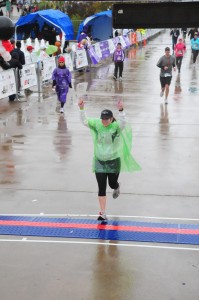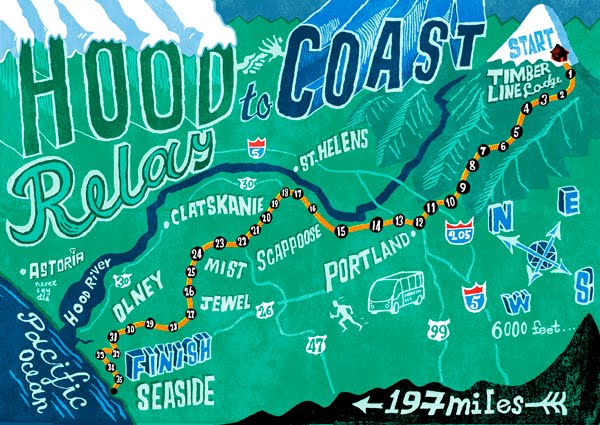We are Teal & Beth from Life is a Run and we are thrilled to be featured in today’s Marathons+Moderation guest post. Who knew our acquaintance type friendship back in 2006 would turn into running buddies?
Teal is a teacher whose desire to get back into shape like the girl she was in high school who was active in every sport propelled her back into running. Beth is a paralegal who was never very good at organized sports and found her own success through running despite being on and off with it throughout the years. When Teal approached Beth about running a half marathon in 2010 little did we know that a seed was planted and Life is a Run would be birthed! We are passionate about our running, staying in shape and trying to stay healthy while having fun at the same time!
How marathon training worked for us
When we set out to run a marathon for the first time we really didn’t have any idea what it would really consist of except for the fact that we would of course be running. We are also not sure exactly how we would handle the running and our busy lives. Whatever we were going to do we knew we would figure it out and do it together. We set up a running schedule and worked around what we knew would be happening in our lives – Birthdays, dinners, weddings, vacations, all those things come up! Our biggest thing was making sure we could and would fit in our long runs around each of those things that come up. We planned months in advance and worked out all the kinks so that every long run would be done together. When we knew we wouldn’t be able to run together we would swap long run days to make it work so if there was one we couldn’t do together it would be one we could for sure make alone. We copied our plan below so you can kind of see just what mess we had to deal with.
When the time came to run we planned! That is the best advice we can give. Grab your calendar, list of commitments and lay it out so there is no guess work involved. We ran our midweek runs typically by ourselves in the mornings and the long runs on the weekends. We cross trained as well. Many times runners think that the weightlifting aspect is not needed, but we 110% believe that it is. We both stayed consistent and trained at least twice a week with our trainers doing weight training and also spent numerous days in the yoga study. The balance is needed and your body craves it.
How To Survive Your Training
So you saw our schedule and here is how we made it through the training.
- Foam Roller: If you don’t have one, GET ONE and not only get one, use it! If you are not sure how, like we were, there are a ton of videos on Youtube about what to do and how to do it on everything from the IT band to calf, to lower back.
2. Calf Sleeves and Compression Gear: Yes, you may look crazy, but it actually helps. We would typically wear our calf sleeves after long runs to sleep it or wear under our pants to work the next day.
3. Ice Baths and Icing: It is horrible at first, we are not going to lie but worth it! A few tips to make ice baths better – wear spandex, wear a sweatshirt, wear a hat and gloves, get in and do something to keep your mind off of it (i.e. catch up on blogs or tweets) and drink a hot drink! Whatever it takes for you to stay in there for 10 minutes. Icing is easier and really a bag of mixed veggies are the best because they form to your body.
4. Stretching: Duh, do it. Yoga helps big time with this!
5. Rest: when you feel like you need it – do it! Your training will suffer more if you don’t.
6. Have some wine: Yep, we mean it! Go out with your friends, drink a drink, laugh, have fun, and don’t get caught up so much in what you are doing that you don’t know your friends anymore.
Trust your training when you are out
So as you can see, we went in to our marathon confident that we had done everything we could. We trained and we did all of those things to not die and we were race ready. Race day approached in Dallas and we were fairly sure that we were going to have good weather. It had been dry but cold, and by dry we mean we were in a record setting draught dry. It hadn’t rained all year. We tracked the weather like crazies and then we saw that it was calling for upper 30’s to 40’s and heavy rain.
We had both bought jackets that we honestly thought we would end up taking off and we had also read a blog about wearing a poncho in the rain and NOT taking it off. We were very much prepared for light rain and cold but not for what we ended up with. The rain held out for the start but as soon as we made it to the start line it started to rain, not just a light mist but actual downpour. We maintained a very good pace and stayed close to the 4:15 pacer. We both felt great despite being wet and around mile 8 or 9 Teal had decided to take off her sopping wet gloves. Biggest mistake ever! By mile 13 she was so cold and shaking because she had lost feeling in her arm. Beth had a hat on and kept her gloves either on her hands or would put them in a pocket but never threw them away, which we think now made one of the biggest differences. The only thing that really helped us was we knew that we could run. We trained up to 22 miles, we missed very few runs and we were in shape. We knew that our bodies could get us there it was just a matter of our minds staying with us. Smiling and cheering with the crowd really helps. Seeing familiar faces does too. We were lucky to have friends and family out there who would give us that boost when we didn’t feel like we could make it.pic
Our marathon was no were near what we wanted, expected, or trained for. Neither one of us had really done that many rains in the rain and especially not in the type of ran we got on marathon day. At the lake part of our course there was one point the raindrops were so big they hurt. It was freezing and you would pass people in medical tents completely out of it. It is hard to keep your muscles loose in that kind of cold and wet and we were tight. The only way out of it was to keep running and we did but nowhere near a pace we had hoped to complete our race in. Both of us had set a goal of a 4:15-4:20 finish for our first and ended up Beth at 4:29 and Teal at 4:40. While this doesn’t seem like much of a disappointment, the race in general kind of got to us. We had accomplished something many don’t do in horrible conditions and still finished very well. We will very much take what we learned from this race and try again at our next marathon.
Marathons are crazy and it is important to respect the distance and to not get caught up in what does not go right!
At points we couldn’t get our food open to eat. Ask a volunteer to help you!
We had taken off our gloves. Do not completely throw them away! Stuff them in a pocket.
We both stepped in too many water puddles (yep, still makes a difference even when you are already wet), but we never took off our ponchos, we stayed on the course, and we finished.
There Is Always Marathon #2
Just the other day we saw someone say that you won’t be prepared for your second marathon until you have forgotten the first. Almost as if your body knows what is coming. We aren’t sure how we feel about the forgetting part but we are sure about learning from it!
What We Have Learned
- Things do not always go as planned and you have to be flexible
- Prepare for more than you think. We had listened to people say- you don’t need that, you don’t need this, etc and really no one knows what you need but you – listen to yourself!
- Like we said early, we just followed a plan and ran. We never altered our pace and we really didn’t do hill, tempo, or speed work. We have learned much more about these different types of runs and would very much suggest using something like the McMillian Calculator to help find your paces for the different types of runs. We have recently started altering pace, speed, and elevation and have already seen a difference in our endurance and strength.
- You HAVE to stay on top of your flexibility and stretching. Teal ended up developing Plantar Fasciitis at the end of training and it got worse after the marathon. Don’t ignore pains and stay on top of stretching even if you don’t want to.
- Be a part of the running community- use twitter, start a blog, get a running group, get a coach, get a partner. There is SO much information and support in the running community! It really has helped us learn as much as we have and it also helps with motivation.
- Track what you are doing! We use Runkeeper and Daily Mile. It is awesome to look back on tough weeks and too see how far you have come. It has also helped us to see how the types of runs mentioned in #3 have helped us.
















